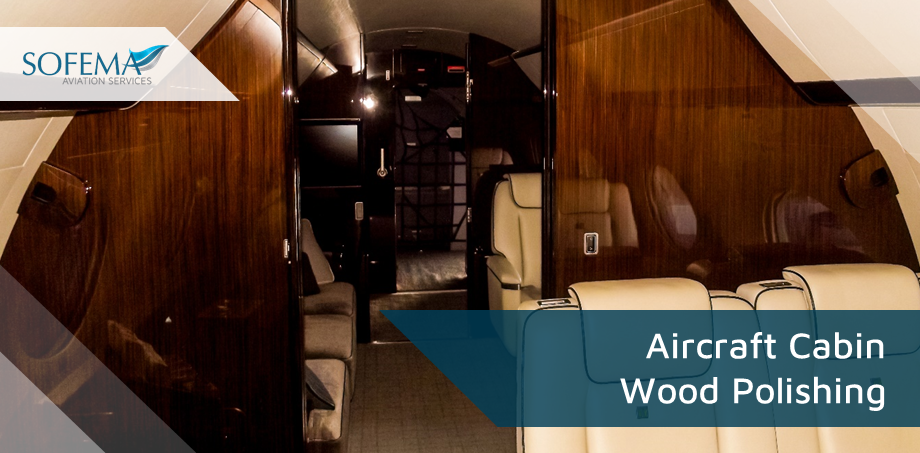Sofema Aviation Services (SAS) www.sassofia.com considers Aircraft Cabin Wood Polishing
Introduction
The presentation of the cabin interior of an aircraft plays a pivotal role in enhancing passenger experience.
Wood, being a timeless and luxurious material, is often used in aircraft cabins to elevate this experience.
- While wooden elements add to the aesthetics and comfort of the flying experience. The wood used, like any other wooden surface, requires regular maintenance to ensure its longevity, appearance, and functionality.
- However, the unique environment of an aircraft, characterized by changes in pressure, humidity, and UV exposure, necessitates specialized care for these wooden elements.
The application of polish in an aircraft cabin is as crucial as the choice of polish.
- Regular maintenance, based on flight hours, ensures the wood remains in pristine condition. Safety, a cornerstone in aviation, must be prioritized. The chosen polish should be non-toxic and free from harmful fumes.
Choice of Wood Polish
The choice of wood polish is paramount. It not only determines the aesthetic appeal but also the longevity of the wood.
- Given the rapid environmental changes within an aircraft, the polish must be resilient, UV-resistant, and durable.
- Among the various options available, Polyurethane (PU) polish, with its water-resistant properties, stands out as a top choice.
o However, its susceptibility to yellowing under UV exposure necessitates the addition of UV light absorbers.
- Lacquer wood polish, known for its quick-drying properties and superior protection, is another viable option. However, one must ensure it is heat resistant and does not emit harmful fumes, especially in the confined space of an aircraft.
- Water-based wood polishes, with their ability to retain clarity over time, are ideal for aircraft cabins.
o Their quick-drying nature ensures minimal downtime, crucial for commercial aircraft with tight schedules.
- Oil-based polishes, while providing a luxurious finish, must be chosen with care. A thick application can trap moisture, detrimental in fluctuating cabin conditions.
Application of Wood Polish within an Aircraft Cabin
Preparing the Surface:
- Before applying any polish, ensure the wooden surface is clean and free from dust, dirt, and grease. Use a mild cleaner and a soft cloth to clean the surface.
- Sanding might be necessary for older surfaces to remove any old polish or imperfections. Use fine-grit sandpaper and sand in the direction of the wood grain. After sanding, remove all dust using a tack cloth.
Safety First:
- Ensure proper ventilation in the cabin during the polishing process. This helps in dissipating any fumes and speeds up the drying process.
- Technicians should wear protective gloves, masks, and safety glasses to protect against any accidental splashes or inhalation of fumes.
Application Technique:
- Use a high-quality brush or a soft cloth for application. Ensure even distribution without leaving streaks.
- Apply thin coats rather than a single thick one. This ensures faster drying and reduces the risk of trapping moisture.
- Always apply polish in the direction of the wood grain. This ensures a smooth finish and enhances the wood’s natural patterns.
Drying Time:
- Respect the drying time mentioned on the polish product. Given the unique environment of an aircraft, it might be beneficial to allow a slightly longer drying time than recommended.
- Avoid touching or using the polished surface until it’s completely dry.
Maintenance:
- Regularly inspect the wooden surfaces for any signs of wear or damage. Early detection can lead to simpler fixes.
- Clean spills immediately to prevent staining or damage to the polish.
- Depending on the traffic and usage, consider re-polishing every few months or as needed.
Storage of Polishing Materials:
- Store all polishing materials in a cool, dry place away from direct sunlight.
- Ensure all containers are sealed properly to prevent the polish from drying out or getting contaminated.
Next Steps
Follow this link to our Library to find & download related documents for Free.
Please see the following training course: Aircraft Servicing, Cleaning, and Detailing – 2 Days. For questions or comments please email team@sassofia.com
Tags:
Aircraft, aviation safety, EASA, Sofema Aviation Services, SAS blogs, Cabin Interiors, Aircraft Cabin, Aicraft Maintenance, Aircraft Servicing, Aircraft Cleaning, Аircraft interior, best practices, Wood Finish Polishing, Aircraft Cabin Wood Polishing




